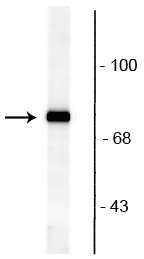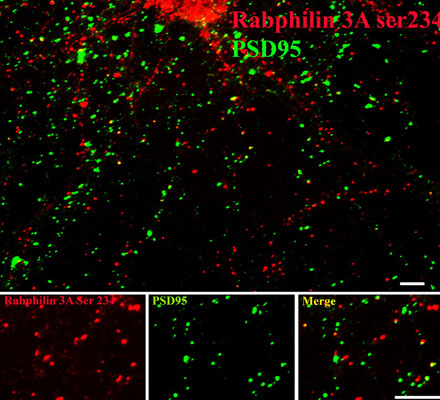Anti-Rabphilin 3A (Ser234) Antibody
Our Anti-Rabphilin 3A (Ser234) rabbit polyclonal phosphospecific primary antibody from PhosphoSoluti
- SPECIFICATION
- CITATIONS
- PROTOCOLS
- BACKGROUND

Application
| WB |
|---|---|
| Primary Accession | P47709 |
| Reactivity | Bovine |
| Host | Rabbit |
| Clonality | Polyclonal |
| Isotype | IgG |
| Calculated MW | 75832 Da |
| Gene ID | 171039 |
|---|---|
| Other Names | Exophilin 1 antibody, Exophilin-1 antibody, Exophilin1 antibody, KIAA0985 antibody, Rabphilin 3A homolog antibody, Rabphilin-3A antibody, Rabphilin3A antibody, RP3A antibody, RP3A_HUMAN antibody, Rph 3a antibody, Rph3a antibody |
| Target/Specificity | Rabphilin-3A is a peripheral membrane protein that binds Ca2+ and phospholipids and is attached to synaptic vesicle membranes (Geppert et al., 1994; Li et al., 1994). The expression of rabphilin 3A is reduced in an animal model of Huntington’s disease (Smith et al., 2005). Rabphilin can be phosphorylated at Ser-234 by both CAM kinase II and PKA and this phosphorylation has been suggested to regulate neuronal activity during development in a synapse-specific manner (Fykse et al., 1995; Foletti and Scheller, 2001). |
| Dilution | WB~~1:1000 |
| Format | Antigen Affinity Purified from Pooled Serum |
| Storage | Maintain refrigerated at 2-8°C for up to 6 months. For long term storage store at -20°C in small aliquots to prevent freeze-thaw cycles. |
| Precautions | Anti-Rabphilin 3A (Ser234) Antibody is for research use only and not for use in diagnostic or therapeutic procedures. |
| Shipping | Blue Ice |

Thousands of laboratories across the world have published research that depended on the performance of antibodies from Abcepta to advance their research. Check out links to articles that cite our products in major peer-reviewed journals, organized by research category.
info@abcepta.com, and receive a free "I Love Antibodies" mug.
Provided below are standard protocols that you may find useful for product applications.
Background
Rabphilin-3A is a peripheral membrane protein that binds Ca2+ and phospholipids and is attached to synaptic vesicle membranes (Geppert et al., 1994; Li et al., 1994). The expression of rabphilin 3A is reduced in an animal model of Huntington’s disease (Smith et al., 2005). Rabphilin can be phosphorylated at Ser-234 by both CAM kinase II and PKA and this phosphorylation has been suggested to regulate neuronal activity during development in a synapse-specific manner (Fykse et al., 1995; Foletti and Scheller, 2001).
If you have used an Abcepta product and would like to share how it has performed, please click on the "Submit Review" button and provide the requested information. Our staff will examine and post your review and contact you if needed.
If you have any additional inquiries please email technical services at tech@abcepta.com.













 Foundational characteristics of cancer include proliferation, angiogenesis, migration, evasion of apoptosis, and cellular immortality. Find key markers for these cellular processes and antibodies to detect them.
Foundational characteristics of cancer include proliferation, angiogenesis, migration, evasion of apoptosis, and cellular immortality. Find key markers for these cellular processes and antibodies to detect them. The SUMOplot™ Analysis Program predicts and scores sumoylation sites in your protein. SUMOylation is a post-translational modification involved in various cellular processes, such as nuclear-cytosolic transport, transcriptional regulation, apoptosis, protein stability, response to stress, and progression through the cell cycle.
The SUMOplot™ Analysis Program predicts and scores sumoylation sites in your protein. SUMOylation is a post-translational modification involved in various cellular processes, such as nuclear-cytosolic transport, transcriptional regulation, apoptosis, protein stability, response to stress, and progression through the cell cycle. The Autophagy Receptor Motif Plotter predicts and scores autophagy receptor binding sites in your protein. Identifying proteins connected to this pathway is critical to understanding the role of autophagy in physiological as well as pathological processes such as development, differentiation, neurodegenerative diseases, stress, infection, and cancer.
The Autophagy Receptor Motif Plotter predicts and scores autophagy receptor binding sites in your protein. Identifying proteins connected to this pathway is critical to understanding the role of autophagy in physiological as well as pathological processes such as development, differentiation, neurodegenerative diseases, stress, infection, and cancer.



